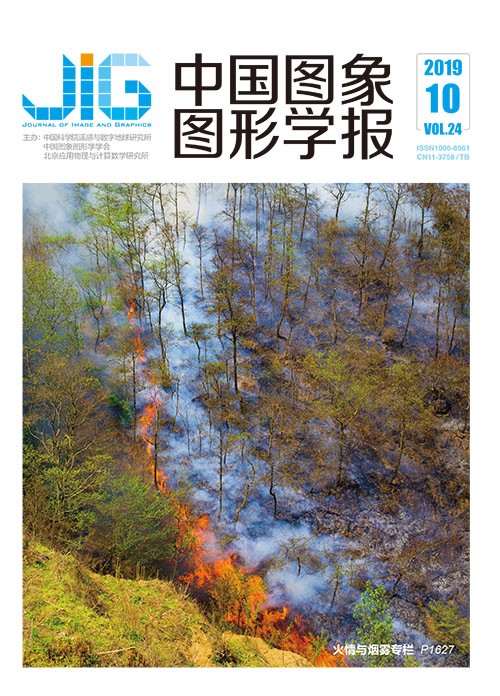
参数可调的通用半正交图像矩模型
何冰1,2, 崔江涛1, 肖斌3, 彭延国1(1.西安电子科技大学计算机科学与技术学院, 西安 710071;2.渭南师范学院数理学院, 渭南 714000;3.重庆邮电大学计算机科学与技术学院, 重庆 400065) 摘 要
目的 为了提高以正交多项式为核函数构造的高阶矩数值的稳定性,增强低阶矩抗噪和滤波的能力,将仅具有全局描述能力的常规正交矩推广到可以局部化提取图像特征的矩模型,从频率特性分析的角度定义一种参数可调的通用半正交矩模型。方法 首先,对传统正交矩的核函数进行合理的修正,以修正后的核函数(也称基函数)替代传统正交矩中的原核函数,使其成为修改后的特例之一。经过修正后的基函数可以有效消除图像矩数值不稳定现象。其次,采用时域的分析方法能够对图像的低阶矩作定量的分析,但无法对图像的高频部分(对应的高阶矩)作更合理的表述。因此提出一种时—频对应的方法来分析和增强不同阶矩的稳定性,通过对修正后核函数的频带宽度微调可以建立性能更优的不同阶矩。最后,利用构建的半正交—三角函数矩研究和分析了通用半正交矩模型的特点及性质。结果 将三角函数为核函数的图像矩与现有的Zernike、伪Zernike、正交傅里叶—梅林矩及贝塞尔—傅里叶矩相比,由于核函数组成简单,且其值域恒定在[-1,1]区间,因此在图像识别领域具有更快的计算速度和更高的稳定性。结论 理论分析和一系列相关图像的仿真实验表明,与传统的正交矩相比,在数值稳定性、图像重构、图像感兴趣区域(ROI)特征检测、噪声鲁棒性测试及不变性识别方面,通用的半正交矩性能及效果更优。
关键词
General semi-orthogonal moments with parameter modulation
He Bing1,2, Cui Jiangtao1, Xiao Bin3, Peng Yanguo1(1.School of Computer Science and Technology, Xidian University, Xi'an 710071, China;2.School of Mathematics and Physics, Weinan Normal University, Weinan 714000, China;3.School of Computer Science and Technology, Chongqing University of Posts and Telecommunications, Chongqing 400065, China) Abstract
Objective This study aims to improve the numerical stability of high-order moments and the ability of anti-noise and filtering for low-order moments, which are defined with orthogonal polynomial kernel-functions. A general semi-orthogonal moments with parameter-modulated is defined from frequency-response analysis, which is a generalization of the traditional orthogonal moments. This paper mainly attempts to study from the following three aspects:1) we take on the challenge of studying the influence of the performance of semi-orthogonal kernel-functions onto an image between orthogonal and non-orthogonal moments and design a general semi-orthogonal moment theory model for different orders; 2) we take on the challenge of trying to establish a theoretical analysis model of image moments in the frequency domain; by adjusting the bandwidth of the basis functions and the corresponding cut-off frequencies for various moments, we can analyze their effects on low-order moments, middle-order moments, and high-order moments and further study the advantages and disadvantages of reconstructed images by using different order moments (low-order and high-order); 3) to solve the traditional orthogonal moments that can only describe the characteristics of the image globally, we take on the challenge of constructing image local feature analysis method and establishing the local image moments of region of interest (ROI) feature extraction. Method The kernel functions of the traditional orthogonal moments are modified appropriately by using the modified kernel-functions (basis functions) to replace the original kernel-functions in the traditional orthogonal moments, making it a special case for modified moments. The modified basis functions can effectively eliminate the numerical instability of image moments. The low-order moments of an image can be quantitatively analyzed by time-domain analysis method, but the high-frequency of an image (corresponding high-order moments) cannot be described reasonably. Therefore, from the perspective of frequency domain, a time-frequency correspondence method is proposed to analyze and enhance the stability of different order moments. The main idea of this method is to treat the representation of the constructed image moments in the frequency domain as a filter (such as low-pass filtering). The bandwidth corresponding to the kernel functions will be wider when using low-order moments, and the cut-off frequency will be attenuated as much as possible. Meanwhile, the bandwidth corresponding to the high-order moments is narrow, and the cutoff frequency attenuates as fast as possible. In summary, various types of optimal-order moments can be established by slightly adjusting the band-width of the modified kernel function. Finally, the semi-orthogonal trigonometric function moments (SOTMs) are implemented to investigate the properties of the general semi-orthogonal moments. Compared with those of existing Zernike, pseudo-Zernike, orthogonal Fourier-Mellin moments, and Bessel-Fourier moments (the above image moments are composed of high-order polynomials), the image moments with triangular functions as basis have faster computational speed and lower computational complexity in image recognition due to their simple composition and the magnitude located in[-1,1]. Result A semi-orthogonal triangular function moment is proposed to generalize the triangular functions, which can construct corresponding image moments in different coordinates space, and to improve the stability and accuracy of image reconstruction. Moments established by triangular functions are used as kernel functions, as verified by theoretical analysis and related simulation experiments. Conclusion Theoretical analysis and a series of simulation experiments for correlated images demonstrate that, the general semi-orthogonal moments outperform corresponding orthogonal moments (e.g., Zernike, pseudo-Zernike, orthogonal Fourier-Mellin moments, and Bessel-Fourier moments) in terms of the numerical stability, image-reconstruction, image ROI feature detection, noise robustness testing, and invariant recognition.
Keywords
|



 中国图象图形学报 │ 京ICP备05080539号-4 │ 本系统由
中国图象图形学报 │ 京ICP备05080539号-4 │ 本系统由